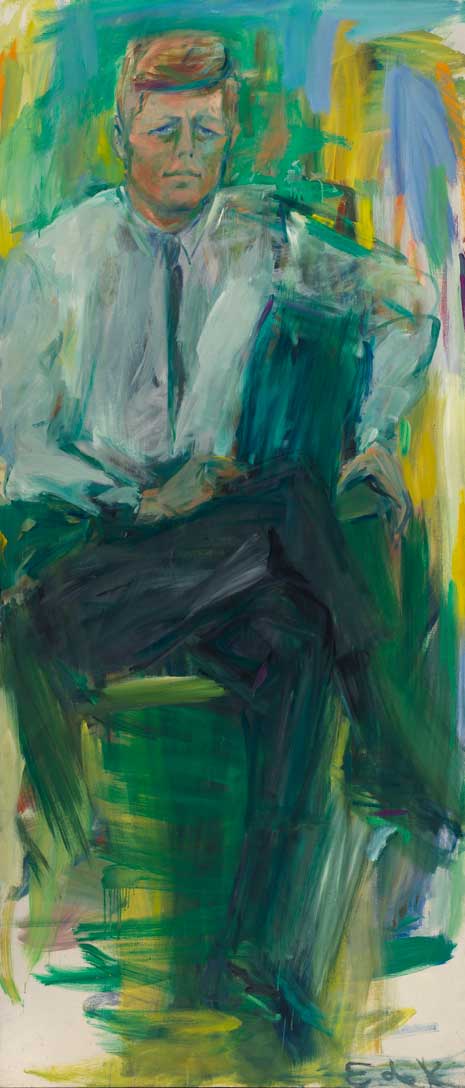Elaine de Kooning's JFK
"Elaine de Kooning: Portraits," a major retrospective of her work, opens today at the National Portrait Gallery.

Frequent visitors to the National Portrait Gallery are most likely familiar with Elaine de Kooning’s portrait of John F. Kennedy in the “America’s Presidents” gallery. Painted in rushing swaths of green, gold, and light blue, it commands attention among the more monochromatic and sober images of our leaders. Now, return visitors as well as newcomers can view this untraditional likeness of our nation’s thirty-fifth president in a major exhibition, “Elaine de Kooning: Portraits,” opening today, March 13. Seen among the sixty-six works in the exhibition, it reaffirms the artist’s uncanny ability to capture the gesture, pose, and spirit of her subjects.
The Portrait Gallery canvas is one of nine images of Kennedy in the exhibition. All result from a commission Elaine received in 1962 to paint an official portrait of JFK for the Truman Library in Independence, Missouri. Elaine was an unorthodox choice for the task, not only because she was female, painting in the abstract expressionist style, and highly individualistic, but also because she had executed few commissioned works in her career. Her portraits were primarily of close friends in the art world and of family, including her husband, artist Willem de Kooning. But Elaine’s skill at recording the essence of a subject in a few sittings won her the job. She traveled to Florida in late December 1962 to meet with the president in Palm Beach.

When I first saw him, he was bigger than life. It wasn’t that he was really taller than the others. But he seemed to be in a different dimension. The eyes were a total surprise to me. I have never seen the color in photographs—the violet of grapes!”
In the golden sunlight of Florida, Kennedy seemed to radiate warmth and color—and an energy that became a struggle for the artist:
All my sketches from life as he talked on the phone, jotted down notes, read papers, held conferences, had to be made very quickly, catching features and gestures, half for memory, even as I looked, because he never sat still. It was not so much that he seemed restless, rather, he sat like an athlete or college boy, constantly shifting in his chair. At first this impression of youthfulness was a hurdle, as was the fact that he never sat still.

After their sessions ended in January 1963, Elaine returned to her studio, using her studies and published photographs to refine the portrait. She was still working on it when she learned that Kennedy had been assassinated in Dallas on November 22. It was months before she could return to the project and attempt to express the vitality of the man she met in Palm Beach. But she did.
She delivered an official portrait to the Truman Library and created many other likenesses of JFK as well. The Portrait Gallery image screams youth, movement, and intensity. There are no symbols of power or democracy. The young president is seated, but hardly still. His left arm stiffly clutches the armrest. His legs are crossed. He seems poised to bolt into the future. There is so much promise contained in his gesture—as if Dallas never happened. In the swirl of brushstrokes and color, he offers what Elaine called a “glimpse” into the real John F. Kennedy.
- Amy Pastan, for the National Portrait Gallery
Cited:
Jean M. White, “To Artist, JFK Was Always in Motion,” Washington Post, October 29, 1964.
Elaine de Kooning, “Remarks on the Dedication of the John F. Kennedy Painting,” Harry S. Truman Library, February 17, 1965, p. 4